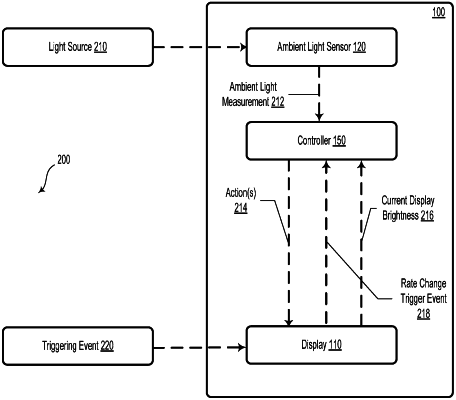| CPC G09G 3/20 (2013.01) [G06F 3/0484 (2013.01); G09G 2320/0247 (2013.01); G09G 2320/041 (2013.01); G09G 2330/021 (2013.01); G09G 2354/00 (2013.01); G09G 2360/144 (2013.01); G09G 2360/16 (2013.01)] | 20 Claims |

|
1. A device comprising:
a display component, wherein the display component is configured to operate at a first refresh rate or a second refresh rate; and
one or more processors operable to perform operations, the operations comprising:
identifying a rate change triggering event while the display component is operating at the first refresh rate;
determining a current brightness value of the display component;
determining, based on an environmental state measurement associated with an environment around the device, a threshold brightness value;
transitioning the display component from the first refresh rate to the second refresh rate in response to identifying the rate change triggering event if the current brightness value of the display component meets or exceeds the threshold brightness value;
identifying a second rate change triggering event while the display component is operating at the second refresh rate; and
after a threshold period of time from the second rate change triggering event, transitioning the display component from the second refresh rate to the first refresh rate.
|
|
19. An article of manufacture including a non-transitory computer-readable medium, having stored thereon program instructions that, upon execution by one or more processors of a computing device, cause the computing device to carry out operations comprising:
identifying a rate change triggering event while a display component of the computing device is operating at a first refresh rate, wherein the display component is configured to operate at the first refresh rate or a second refresh rate;
determining a current brightness value of the display component;
determining, based on an environmental state measurement associated with an environment around the computing device, a threshold brightness value;
transitioning the display component from the first refresh rate to the second refresh rate in response to identifying the rate change triggering event if the current brightness value meets or exceeds the threshold brightness value;
identifying a second rate change triggering event while the display component is operating at the second refresh rate; and
after a threshold period of time from the second rate change triggering event, transitioning the display component from the second refresh rate to the first refresh rate.
|
|
20. The device of claim 1, wherein the first rate change triggering event comprises one or more of a notification received from a remote computing device, an event associated with a battery level of the device, or an application related event.
|